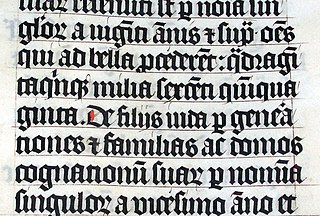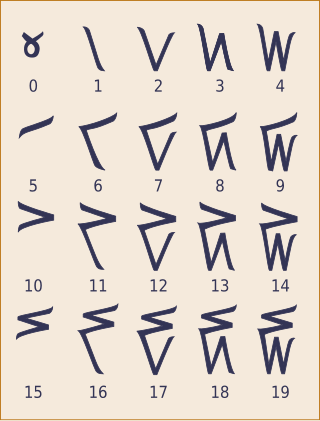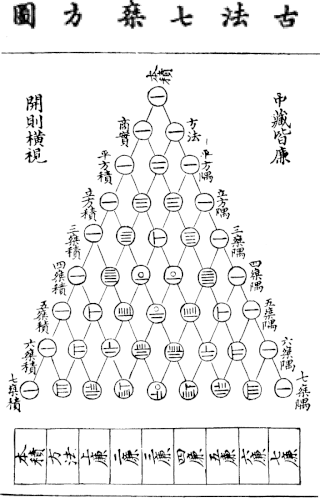The ten Arabic numerals 0, 1, 2, 3, 4, 5, 6, 7, 8, and 9 are the most commonly used symbols for writing numbers. The term often also implies a positional notation using the numerals, as well as the use of a decimal base, in particular when contrasted with other systems such as Roman numerals. However, the symbols are also used to write numbers in other bases such as octal, as well as for writing non-numerical information such as trademarks or license plate identifiers.
Chinese numerals are words and characters used to denote numbers in written Chinese.
The system of Hebrew numerals is a quasi-decimal alphabetic numeral system using the letters of the Hebrew alphabet. The system was adapted from that of the Greek numerals sometime between 200 and 78 BCE, the latter being the date of the earliest archeological evidence.

The Maya numeral system was the system to represent numbers and calendar dates in the Maya civilization. It was a vigesimal (base-20) positional numeral system. The numerals are made up of three symbols: zero, one and five. For example, thirteen is written as three dots in a horizontal row above two horizontal bars; sometimes it is also written as three vertical dots to the left of two vertical bars. With these three symbols, each of the twenty vigesimal digits could be written.

Roman numerals are a numeral system that originated in ancient Rome and remained the usual way of writing numbers throughout Europe well into the Late Middle Ages. Numbers are written with combinations of letters from the Latin alphabet, each letter with a fixed integer value. Modern style uses only these seven:
0 (zero) is a number representing an empty quantity. Adding 0 to any number leaves that number unchanged. In mathematical terminology, 0 is the additive identity of the integers, rational numbers, real numbers, and complex numbers, as well as other algebraic structures. Multiplying any number by 0 has the result 0, and consequently, division by zero has no meaning in arithmetic.
In Western musical notation, the staff, also occasionally referred to as a pentagram, is a set of five horizontal lines and four spaces that each represent a different musical pitch or in the case of a percussion staff, different percussion instruments. Appropriate music symbols, depending on the intended effect, are placed on the staff according to their corresponding pitch or function. Musical notes are placed by pitch, percussion notes are placed by instrument, and rests and other symbols are placed by convention.
Greek numerals, also known as Ionic, Ionian, Milesian, or Alexandrian numerals, are a system of writing numbers using the letters of the Greek alphabet. In modern Greece, they are still used for ordinal numbers and in contexts similar to those in which Roman numerals are still used in the Western world. For ordinary cardinal numbers, however, modern Greece uses Arabic numerals.
A numerical digit is a single symbol used alone or in combinations, to represent numbers in a positional numeral system. The name "digit" comes from the fact that the ten digits of the hands correspond to the ten symbols of the common base 10 numeral system, i.e. the decimal digits.

Positional notation usually denotes the extension to any base of the Hindu–Arabic numeral system. More generally, a positional system is a numeral system in which the contribution of a digit to the value of a number is the value of the digit multiplied by a factor determined by the position of the digit. In early numeral systems, such as Roman numerals, a digit has only one value: I means one, X means ten and C a hundred. In modern positional systems, such as the decimal system, the position of the digit means that its value must be multiplied by some value: in 555, the three identical symbols represent five hundreds, five tens, and five units, respectively, due to their different positions in the digit string.

Pentadic numerals are a notation for presenting numbers, usually by inscribing in wood or stone. The notation has been used in Scandinavia, usually in conjunction with runic calendars and inscriptions in runes.

Scribal abbreviations or sigla are abbreviations used by ancient and medieval scribes writing in various languages, including Latin, Greek, Old English and Old Norse.
The system of ancient Egyptian numerals was used in Ancient Egypt from around 3000 B.C. until the early first millennium A.D.. It was a system of numeration based on multiples of ten, often rounded off to the higher power, written in hieroglyphs. The Egyptians had no concept of a positional notation such as the decimal system. The hieratic form of numerals stressed an exact finite series notation, ciphered one-to-one onto the Egyptian alphabet.
The Suzhou numerals, also known as Sūzhōu mǎzi (蘇州碼子), is a numeral system used in China before the introduction of Hindu numerals. The Suzhou numerals are also known as huāmǎ (花碼), cǎomǎ (草碼), jīngzǐmǎ (菁仔碼), fānzǐmǎ (番仔碼) and shāngmǎ (商碼).

The Hindu–Arabic numeral system or Indo-Arabic numeral system is a positional base ten numeral system for representing integers; its extension to non-integers is the decimal numeral system, which is presently the most common numeral system.
A numeral is a character that denotes a number. The decimal number digits 0–9 are used widely in various writing systems throughout the world, however the graphemes representing the decimal digits differ widely. Therefore Unicode includes 22 different sets of graphemes for the decimal digits, and also various decimal points, thousands separators, negative signs, etc. Unicode also includes several non-decimal numerals such as Aegean numerals, Roman numerals, counting rod numerals, Mayan numerals, Cuneiform numerals and ancient Greek numerals. There is also a large number of typographical variations of the Western Arabic numerals provided for specialized mathematical use and for compatibility with earlier character sets, such as ² or ②, and composite characters such as ½.

The Kaktovik numerals or Kaktovik Iñupiaq numerals are a base-20 system of numerical digits created by Alaskan Iñupiat. They are visually iconic, with shapes that indicate the number being represented.

Counting rods are small bars, typically 3–14 cm long, that were used by mathematicians for calculation in ancient East Asia. They are placed either horizontally or vertically to represent any integer or rational number.
An alphabetic numeral system is a type of numeral system. Developed in classical antiquity, it flourished during the early Middle Ages. In alphabetic numeral systems, numbers are written using the characters of an alphabet, syllabary, or another writing system. Unlike acrophonic numeral systems, where a numeral is represented by the first letter of the lexical name of the numeral, alphabetic numeral systems can arbitrarily assign letters to numerical values. Some systems, including the Arabic, Georgian and Hebrew systems, use an already established alphabetical order. Alphabetic numeral systems originated with Greek numerals around 600 BC and became largely extinct by the 16th century. After the development of positional numeral systems like Hindu–Arabic numerals, the use of alphabetic numeral systems dwindled to predominantly ordered lists, pagination, religious functions, and divinatory magic.















